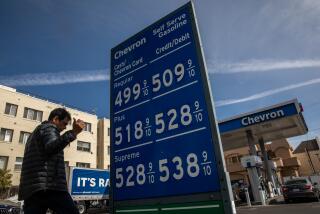Oil Prices Surge and May Keep Going Up
The year ended in fitting fashion for the petroleum world Friday: Oil futures prices jumped higher. So did gasoline, natural gas and heating oil contracts.
And consumers can expect more of the same in 2006.
Spurred by supply worries that will stretch into next year, traders sent the cost of crude oil for February delivery up 72 cents to $61.04 a barrel Friday in a holiday-shortened session on the New York Mercantile Exchange. Oil prices rose 4.5% on the week and finished $17.59 a barrel, or 40%, higher than on the final trading day of 2004.
Gasoline futures jumped 5.76 cents to $1.71 a gallon, 57% higher than a year earlier. Heating oil rose 2.51 cents to $1.728 a gallon on the Nymex, up 41% during 2005. Natural gas, which ended the year more than 80% higher than it started, rose 0.2 cent to $11.225 per million British thermal units.
The closing prices were well below records set during 2005, but analysts warned that production limits and rising demand would push up the cost of oil and its byproducts in the year ahead -- stretching consumer and business budgets in the process.
âWe donât see crude oil coming down until there is additional supply, and we donât see that happening for four to five years,â said David Hackett, president of Stillwater Associates, an industry consulting firm based in Irvine. âOur view is that it stays high and volatile.â
Demand for oil has been growing worldwide, but the largest driver has been economic growth in the United States, China and India.
The surge in oil usage has come at a time when crudeproducing countries are already pumping oil out of the ground at near-peak levels.
Oil prices soared after hurricanes Katrina and Rita destroyed drilling and production rigs in the Gulf of Mexico, and they closed Aug. 30 at a record $69.81 a barrel on the Nymex after briefly trading above $70.
With little margin for error, world oil markets have become skittish and prone to wild price swings based on trading momentum, rumors, weather or relatively small glitches in pipelines or production facilities. All those factors will be present -- and possibly worse, given rising demand -- in 2006, experts say.
Revised projections for global oil supply and demand caused Barclays Capital energy analyst Paul Horsnell to joke in a Dec. 14 report that âwe are now investigating precisely how much oil-tank storage we can build in the garden.â
On the gasoline front, consumers suffered through record prices that zoomed past the $3-a-gallon mark after the hurricanes, peaking at an average $3.057 a gallon nationwide in early September. In a reversal of the norm, California maintained slightly lower prices during the period, hitting a statewide average high of $3.054 a gallon.
The storms knocked out nearly a third of the nationâs refining capacity and cut gasoline production for months. Imports helped fill the gap, but the disaster laid bare the nationâs growing fuel-making deficit.
In recent weeks, consumers have enjoyed a respite at the pumps as seasonally lower demand pushed down prices nationwide. In California this week, a few stations made news for selling self-serve regular for less than $2 a gallon -- a benchmark that many stations were well under in December 2004.
Nationwide pump prices for regular averaged $2.19 a gallon Friday, 41 cents higher than year-earlier levels, according to AAA. Self-serve regular in California averaged $2.233 a gallon, 21 cents above the year-earlier average.
Michael Armbruster, co-founder and energy analyst at Altavest Worldwide Trading Inc. in Mission Viejo, said rising fuel demand in 2006 would further strain U.S. refineries.
In addition, new limits on sulfur in gasoline would cut the country from some of its import suppliers.
âEvery year, weâre becoming more and more dependent on foreign countries refining crude oil for us,â Armbruster said. At the pumps next year, he added, âI would expect steady to higher prices.â
More to Read
Inside the business of entertainment
The Wide Shot brings you news, analysis and insights on everything from streaming wars to production â and what it all means for the future.
You may occasionally receive promotional content from the Los Angeles Times.










